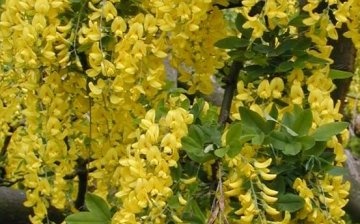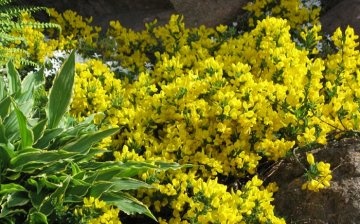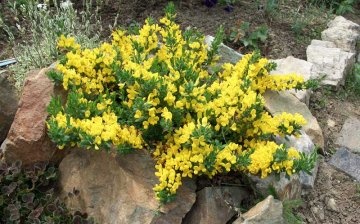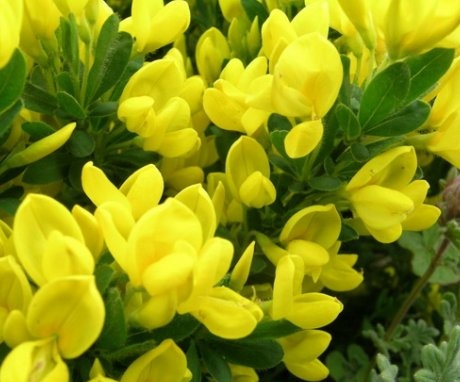Broom in the photo and its cultivation
If we consider the broom in the photo, then it is presented as a shrub reaching a height of 0.5-3 m. It is used to strengthen and decorate wastelands, sandy slopes. Broom flowers are bright yellow, yellow-white, purple, cream.
Content:
- Common types of broom
- Growing broom
- Reproduction of broom
- Healing and decorative properties of broom
Common types of broom
Some brooms with fragrant flowers are grown in gardens and in the country.
The most famous are:
- Coronal broom (Cytisus scoparius). It reaches a height of 3 meters. Small leaves of an oval or oblong-lanceolate shape are placed on thin green shoots. The flowers are yellow, irregular in shape, up to 2 cm in size. The plant is frost-resistant, tolerates frosts down to -20 degrees. Leaves fall very early. It is widely cultivated in Europe and in regions with a mild climate. Blooms in April - May.
- Early broom (Cytisus praecox). The shrub reaches a height of 1.5 meters. It is the most unpretentious species. Arcuate branches, scattered to the sides, form a dense crown. The leaves are narrow, small, up to 2 cm in size. Bright yellow flowers are abundantly clinging to the branches. The plant is winter-hardy, grows quickly, blooms, like the Venichny broom, in April - May.
- Russian broom (Cytisus ruthenicus). Frost and drought-resistant species, reaches 2 meters in height, branches are slightly curving, grayish-brown in color. The leaves are trifoliate, up to 1.6 cm long, and the flowers are large, yellow, located from 2 to 5 pieces in the leaf axils. It grows in Europe, the Caucasus and the southwestern part of Siberia. Blooms in May - July.
- Broom Purple (Cytisus purpureus). Creeping fast-growing shrub with a spreading green crown. It reaches a height of only 0.6 meters. The branches are densely covered with leaves. It blooms with purple and lilac flowers in June - July. It freezes in winter, but recovers in spring. Grows in the central and southern parts of Europe.
Growing broom
The broom loves sunny places that are reliably protected from drafts and wind. As for the earth, it must be loose. The optimal soil composition is a mixture of turf, sand and humus. You also need to add a full complex mineral fertilizers.
The broom is planted at a distance of 30-50 cm from each other so that the neck of the plant is at ground level, and river pebbles are placed on the bottom of the pit for drainage. After landing soil around the broom, mulch with peat or soil 5 cm thick.
Care includes regular weeding, pruning and top dressing. So, purple broom must be fertilized before flowering. To do this, mix potassium sulfate and granular superphosphate. If you notice that the shrub grows poorly, you can add some wood ash under the bush. The broom is covered with spruce branches for the winter. Shelter is especially necessary for young one- and two-year-old plants.
All varieties are drought tolerant. Therefore, if there is sufficient rainfall during the spring and summer, additional watering is not required. In dry weather, it is enough to water the plant once a week in the evening.
After flowering, part of the shoots is cut off to lateral branching in order to stimulate the growth of young shoots and the establishment of a significant number of buds.
Reproduction of broom
The broom is propagated by green cuttings, layering and seeds:
- Cut broom from June to July, for which slightly lignified cuttings about 20 cm long are cut, 3 or 4 leaves are left on them and placed in boxes with moist soil, consisting of peat and sand in equal proportions. The box is covered with a plastic transparent film and the cuttings are rooted at a temperature of about +20 degrees for about a month and a half.
- Broom seeds are sown in spring in boxes with peat and sand to a depth of 5 mm. In order for the seeds to germinate, they are pre-stratified for two months. A box with seedlings is kept in partial shade at a temperature of + 18–20 degrees and with sufficient air and soil moisture.
- In order to obtain layering, the branches of an adult broom are folded back, placed in prepared holes and sprinkled with soil.
Healing and decorative properties of broom
If you study the healing properties, then the Russian broom deserves the most attention. Immediately after flowering, it is necessary to collect the upper parts of the plant with young flowers.
The broom contains flavonoids that remove chloride compounds from the body and have a diuretic effect. A prepared decoction or infusion is useful for angina pectoris, migraine, jaundice and cholecystitis.
In garden design, broom is used both in a single planting and in a group. During a bright bloom, it creates a spectacular contrast with conifers. It is used in rocky gardens and on alpine coaster.
Due to the long flowering, brooms are planted in containers and decorate with them various parts of the garden, terraces, courtyards.













